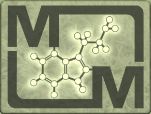 |
MAGISKA MOLEKYLERS WIKI |
Gymnopilus
Inneh├źller: Psilocybin, Psilocin, Baeocystin
Generell information
Sl├żkte i familjen Cortinariaceae.
F├Črutom psilocybinliknande molekyler finns det ├żven arter som inneh├źller kavalaktonerna bis-noryangonin (4-hydroxy-6-(4-hydrostyryl)-2-pyrone) och hispidin (4-hydroxy-6-(3,4-dihydroxystyryl)-2-pyrone)[1] som ├żr strukturellt lika den aktiva drogen i kava. Det finns ├żven en substans som heter gymnopilin som spekuleras ha en psykoaktiv effekt[2], eventuellt genom att verka h├żmmande p├ź nikotinerga acetylkolinreceptorer (nAChR)[3].
I Sverige ├źterfinns arten Gymnopilus junonius (Gymnopilus spectabilis) som dock f├Črmodligen inte inneh├źller psilocybin. Observera ├żven att sm├ź exemplar bl.a kan f├Črv├żxlas med giftiga arter i sl├żktet Galerina.
Under 2010-talet p├źtr├żffades flera flish├Čgar med G. luteofolius i norra Norge[4] det ├żr ok├żnt hur de d├Čk upp d├żr d├ź arten normalt finns i betydligt varmare klimat som s├Čdra USA, Brazilien m.m.
i Japan finns det rapporter om svampf├Črgiftningar med psykiska effekter och namnet "laughing gyms" ger en ledtr├źd om effekterna. I USA har ganska m├źnga personer haft framg├źngsrika resultat av att ├żta de inhemska aktiva arterna.
Enda nackdelen ├żr att smaken av svamparna ├żr mycket bitter, en egenskap som tillskrivs gymnopilin.
Aktiva arter
| ŌĆ£ | To date, 10 species have been shown to be psilocybinactive, according to a survey of the scientific literature by Allen and Gartz (1992). They are G. aeruginosus, G. braendlei, G. intermedius, G. luteoviridis, G. liquiritiae, G. lutes, G. purpuratus, G. spectabilis, G. validipes, and G. viridans (see also Ha tfield et al. 1978). I believe an additional species, G. luteofolius, is also active. (The analysis of this species has not yet been reported in the literature.) G. luteofolius bruises bluish, especially in cold weather. Additionally, a Mexican Gymnopilus, Gymnopilus subpurpuratus, is also likely to be active, given its green bruising reaction (Stamets 1996).
Small amounts of the active compound baeocystin (.02% to .05%) have been found in G. purpuratus (GARTZ 1996). Of G. spectabilis, STAMETS (citing TANAKA et al. 1993) notes that recent studies of Japanese mushrooms detected no psilocybin, ŌĆ£but identified a new hallucinogen, which they described as belonging to a group of ŌĆśneurotoxicŌĆÖ oligoisoprenoids, with depolarizing activity that was demonstrated on rodent neurons. (No human bioassays were conducted.)ŌĆØ (STAMETS 1996). OTT notes that bis-noryangonin (a chemical apparently structurally similar to the active pyrones found in Piper methysticum) has been found in G. spectabilis (OTT 1996, citing HATFIELD & BRADY 1969; HATFIELD & BRADY 1971; and OTT 1976). However, JOCHEN GARTZ points out that this compound is inactive (GARTZ 1996). |
ŌĆØ |
En ny DNA-studie fr├źn 2020 visar att Gymnopilus junonius best├źr av flera arter med liknande utseende[5]. G. junonius finns inte i Nordamerika eller Norra Asien d├żr den anses vara psykoaktiv. Denna uppt├żckten kan f├Črklara varf├Čr den europeiska G. junonius s├żllan/inte rapporterats i fallbeskrivningar. Personer som trippat p├ź den i Europa kan ha hittat andra arter.
| ŌĆ£ | One striking finding is that Gymnopilus junonius does not occur in North America, and is not psychoactive. It occurs in Europe, Australia and South America, solving the mystery of why European big laughing gyms consistently fail to cause laughter.
The mushrooms we have been calling Gymnopilus junonius in eastern North America fall into four species - the previously described Gymnopilus subspectabilis and G. luteus, and the newly named Gymnopilus voitkii and Gymnopilus speciosissimus. Only G. speciosissimus is mentioned as staining green in the paper, but some or all of the others definitely also contain psilocybin. The species can be difficult to tell apart macroscopically, but are easy to separate with a microscope or via DNA sequencing. ...Gymnopilus orientispectabilis is also named here, a large, hallucinogenic species from Japan. |
ŌĆØ |
| Namn | Inneh├źller | K├żlla / Kommentar |
|---|---|---|
| Gymnopilus aeruginosus | Psilocybin | Gartz, 1994b; Hatfield, Valdez & Smith, 1978 |
| Gymnopilus braendlei | N/A | N/A |
| Gymnopilus intermedius | N/A | N/A |
| Gymnopilus junonius (Gymnopilus spectabilis) | F├Črmodligen inte Psilocybin | N/A |
| Gymnopilus lateritius | N/A | N/A |
| Gymnopilus liquiritiae | Psilocybin | Koike et al., 1981 |
| Gymnopilus luteofolius | N/A | N/A |
| Gymnopilus luteoviridis | N/A | N/A |
| Gymnopilus luteus | Psilocybin | Hatfield, Valdez & Smith, 1978 |
| Gymnopilus orientispectabilis | bis-noryangonin, gymnopilin | Troddes tidigare vara Gymnopilus junonius. ├ģterfinns i Asien och ├żr psykoaktiv[1] och [2] |
| Gymnopilus purpuratus | Psilocybin, psilocin, baeocystin | Gartz, 1989c; Gartz, 1991; Gartz, 1992b; Gartz, 1993a; Gartz, 1994b; Gartz, 1996; Kreisel & Lindequist, 1988 |
| Gymnopilus sapineus | N/A | N/A |
| Gymnopilus speciosissimus | Psilocybin, | Psilocybinreferens: Buck, 1967; Hatfield, Valdez and Smith, 1977. Detta ├żr en art fr├źn Nordamerika som tidigare troddes vara Gymnopilus junonius |
| Gymnopilus subpurpuratus | N/A | N/A |
| Gymnopilus validipes | Psilocybin | Hatfield, Valdez & Smith, 1978; Unsigned, 1972b |
| Gymnopilus viridans | Psilocybin | Hatfield, Valdez & Smith, 1978 |
| Gymnopilus voitkii | N/A | N/A. Troddes tidigare vara Gymnopilus junonius |
Externa l├żnkar
- Ōåæ 1,0 1,1 Occurrence of bis-noryangonin in Gymnopilus spectabilis. (Hatfield, 1969)
- Ōåæ 2,0 2,1 Gymnopilin--a substance produced by the hallucinogenic mushroom, Gymnopilus junonius--mobilizes intracellular Ca(2+) in dorsal root ganglion cells. (Miyazaki, 2012)
- Ōåæ Gymnopilins, a product of a hallucinogenic mushroom, inhibit the nicotinic acetylcholine receptor (Kayano, 2014)
- Ōåæ Mathiassen, G., Granmo, A. & Mohn Jenssen, K. 2016: A sensational mushroom find in Lavangsdalen, Troms county. Polarflokken 38 (2): 113-128
- Ōåæ New species in the Gymnopilus junonius group(Basidiomycota: Agaricales) (Thorn, 2020) pdf-version
- Ōåæ Shroomery: New paper on the Gymnopilus junonius group
A Trial Key to GYMNOPILUS in the Pacific Northwest Identifieringsnyckel
Sidan ├żndrades senast 5 mars 2021 klockan 17.22.
Den h├żr sidan har visats 8┬Ā706 g├źnger.











